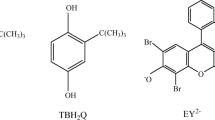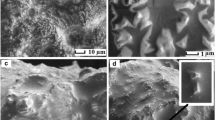Abstract
The aim of our present work was to study the possibility of constructing a biosensor based on immobilized catalase enzyme (EC 1.11.1.6.) in organic-phase solutions. The catalase enzyme was immobilized by glutaraldehyde on a natural protein membrane in a thin-layer enzyme cell, connected to a stopped-flow injection analyser (SFIA) system with an amperometric detector. Adding FMCA to acetonitrile, the optimal concentration was 7.5 mg l−1, while with TBATS it was 2.7 mg l−1. The optimal pH value of the immobilized enzyme in buffer was about 6.0. On studying the role of the buffer solution used in the carrier solvent, the activity of the enzyme changed dramatically. The signal was highest when there was no buffer added to the carrier solution and decreased rapidly when the content increased (0–1.5%). Utilizing these results, a quick analytical method was developed to monitor indirectly the water content (activator) in various butter and margarine samples by maintaining a fixed substrate concentration. The water content of samples was compared with the results obtained by the gravimetric reference method (AOAC Method 920.116); the correlation coefficient (r) was 0.993.






Similar content being viewed by others
References
Campanella L, Martini U, Sammartino MP, Tomassetti M (1996) Electroanalysis 8:1150–1154
Campanella L, Favero G, Sammartino MP, Tomassetti M (1998) Talanta 46:595–606
Narayan VS, Klibanov AM (1993) Biotechnol Bioeng 41:390–393
Triantafyllou AÖ, Wehtje E, Adlercreutz P (1997) Biotechnol Bioeng 54:67–76
Halling PJ (2000) Curr Opin Chem Biol 4:74–80
Rees DG, Halling PJ (2000) Enzyme Microb Technol 27:549–559
Wang B, Dong S (2000) J Electroanal Chem 487:45–50
Wang B, Zhang J, Dong S (2000) Biosens Bioelectron 15:397–402
Campanella L, Fortuney A, Sammartino MP, Tomassetti M (1994) Talanta 41:1397–1404
Mannino S, Cosio MS, Wang J (1994) Analyst 119:2001–2003
Miyabayashi A, Reslow M, Adlercreutz P, Mattiasson B (1989) Anal Chim Acta 219:27–36
Campanella L, Tomassetti M (1996) Food Technol Biotechnol 34:131–141
Iwuoha EI, Smyth MR (1994) Anal Proc 31:19–21
Iwuoha EI, Smyth MR (1994) Analyst 119:265–267
Iwouha EI, Leicester I, Miland E, Smyth MR, Fágáin CO (1997) Anal Chem 69(8):1674–1681
Iwuoha EI, Smyth MR, Lyons MEG (1997) Biosens Bioelectron 12:53–75
Li J, Tan SN, Oh JT (1998) J Electroanal Chem 448:69–77
Liu WH, Houng WC, Tsai MS (1996) Enzyme Microb Technol 18:184–189
León R, Fernandes P, Pinheiro HM, Cabral JMS (1998) Enzyme Microb Technol 23:483–500
Magner E, Klibanov AM (1995) Biotechnol Bioeng 46:175–179
Wang J, Rivas G, Liu J (1995) Anal Lett 28:2287–2295
Horozova E, Dimcheva N, Jordanova Z (2002) Bioelectrochemistry 58:181–187
Campanella L, Sammartino MP, Tomassetti M, Zannella S (2001) Sens Actuators B Chem 76:158–165
Hyun J, Young J-Y, Ryu DDY (1996) Enzyme Microb Technol 19(1):50–56
Khmelnitsky YL, Lavashov AV, Klyachko NL, Martinek K (1988) Enzyme Microb Technol 10:710–724
Váradi M, Adányi N, Nagy G, Rezessy-Szabó J (1993) Biosens Bioelectron 8:339–345
Szabó EE, Adányi N, Váradi M (1996) Biosens Bioelectron 11:1051–1058
Adányi N, Tóth-Markus M, Szabó EE, Váradi M, Sammartino MP, Tomassetti M, Campanella L (2004) Anal Chim Acta 501(2):219–225
Author information
Authors and Affiliations
Corresponding author
Rights and permissions
About this article
Cite this article
Adányi, N., Váradi, M. Catalase-based thin-layer enzyme cell used in organic-phase FIA system for determination of moisture in oily foods. Eur Food Res Technol 219, 432–437 (2004). https://doi.org/10.1007/s00217-004-0961-y
Received:
Revised:
Published:
Issue Date:
DOI: https://doi.org/10.1007/s00217-004-0961-y




